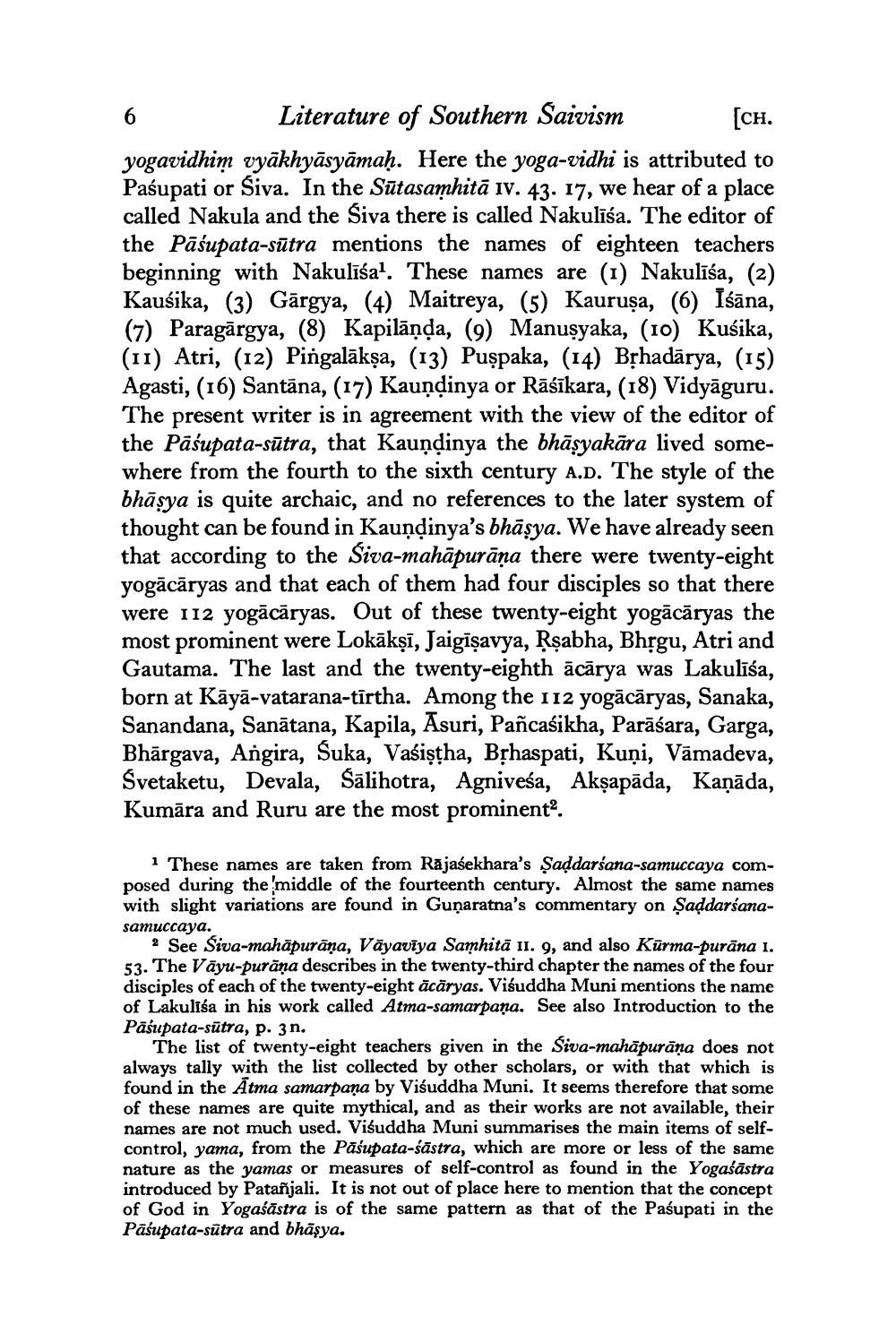________________
Literature of Southern Saivism [CH. yogavidhim vyākhyāsyāmaḥ. Here the yoga-vidhi is attributed to Pasupati or Siva. In the Sūtasamhitā iv. 43. 17, we hear of a place called Nakula and the Siva there is called Nakulīša. The editor of the Pāśupata-sūtra mentions the names of eighteen teachers beginning with Nakulīsa. These names are (1) Nakulīša, (2) Kausika, (3) Gārgya, (4) Maitreya, (5) Kauruşa, (6) Iśāna, (7) Paragārgya, (8) Kapilānda, (9) Manuşyaka, (10) Kuśika, (11) Atri, (12) Pingalākşa, (13) Puşpaka, (14) Bșhadārya, (15) Agasti, (16) Santāna, (17) Kauņdinya or Rāśīkara, (18) Vidyāguru. The present writer is in agreement with the view of the editor of the Pāśupata-sūtra, that Kauņdinya the bhāșyakāra lived somewhere from the fourth to the sixth century A.D. The style of the bhāsya is quite archaic, and no references to the later system of thought can be found in Kauņdinya's bhāsya. We have already seen that according to the Siva-mahāpurāna there were twenty-eight yogācāryas and that each of them had four disciples so that there were 112 yogācāryas. Out of these twenty-eight yogācāryas the most prominent were Lokākṣī, Jaigīşavya, Rşabha, Bhrgu, Atri and Gautama. The last and the twenty-eighth ācārya was Lakulīša, born at Kāyā-vatarana-tīrtha. Among the 112 yogācāryas, Sanaka, Sanandana, Sanātana, Kapila, Asuri, Pañcaśikha, Parāśara, Garga, Bhārgava, Angira, Suka, Vaśiştha, Bphaspati, Kuņi, Vāmadeva, Svetaketu, Devala, Sālihotra, Agniveśa, Akşapāda, Kaņāda, Kumāra and Ruru are the most prominenta.
i These names are taken from Rajasekhara's Şaddarśana-samuccaya composed during the middle of the fourteenth century. Almost the same names with slight variations are found in Gunaratna's commentary on Şaddarśanasamuccaya.
2 See Siva-mahāpurāna, Vāyaviya Samhita 11. 9, and also Kūrma-purāna i. 53. The Vāyu-purāna describes in the twenty-third chapter the names of the four disciples of each of the twenty-eight ācāryas. Visuddha Muni mentions the name of Lakulīša in his work called Atma-samarpana. See also Introduction to the Pāśupata-sūtra, p. 3n.
The list of twenty-eight teachers given in the Siva-mahāpurāņa does not always tally with the list collected by other scholars, or with that which is found in the Atma samarpana by Visuddha Muni. It seems therefore that some of these names are quite mythical, and as their works are not available, their names are not much used. Viśuddha Muni summarises the main items of selfcontrol, yama, from the Pasupata-śāstra, which are more or less of the same nature as the yamas or measures of self-control as found in the Yogaśāstra introduced by Patañjali. It is not out of place here to mention that the concept of God in Yogaśāstra is of the same pattern as that of the Pasupati in the Pāśupata-sūtra and bhāşya.




